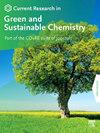含铜和银纳米颗粒的植物水萃取物和酒精萃取物对大肠杆菌和奇异变形杆菌的激动和拮抗作用
Q2 Materials Science
Current Research in Green and Sustainable Chemistry
Pub Date : 2025-01-01
DOI:10.1016/j.crgsc.2025.100475
引用次数: 0
摘要
本研究旨在探讨并比较纳米铜和纳米银以及蓍草和洋甘菊水提液和醇提液对大肠杆菌和奇异杆菌的抑制作用。以洋甘菊和蓍草的鲜叶为原料,采用浸渍法制备提取物。通过化学回收法制备了铜NPs和银NPs。通过抑制区(ZoI)的变化来测定其杀菌效果。没有ZoI被解释为耐药,>; 5mm为半敏感,>; 5mm为敏感。结果表明,NPs的尺寸约为7 nm。洋甘菊和蓍草水提物中大肠杆菌的ZoI直径大于神奇芽孢杆菌,而在酒精提取物中这种关系相反。铜和银的NPs浓度均为0.4 μg/μL,是两种细菌的最有效杀菌NPs浓度。铜NPs及其提取物对大肠杆菌和奇异芽孢杆菌的综合作用表明,当铜NPs浓度为0.4 μg/μL时,洋甘菊醇提物(11 mm)和蓍草水提物(13 mm)的ZoI最大。铜NPs对大肠杆菌和奇异杆菌具有拮抗作用,铜NPs浓度的增加导致非生长晕直径的增大。比较提取液-纳米颗粒组合对4种抗生素的抗菌谱试验结果,发现环丙沙星对大肠杆菌形成的ZoI直径为24 mm,对奇异杆菌形成的ZoI直径为35 mm。环丙沙星对大肠杆菌的ZoI与其他抗生素相比差异显著,洋甘菊醇提物和蓍草水提物对大肠杆菌和神奇杆菌的ZoI差异显著(p <;0.05)。此外,在500 μL和250 μL浓度下,银NPs +亚蓍草水提物和铜NPs +亚蓍草水提物的组合分别具有最小抑菌浓度(MIC)和最小杀菌浓度(MBC)。未来的研究应继续探索这些参数,以开发更有效和可持续的纳米颗粒合成方法。本文章由计算机程序翻译,如有差异,请以英文原文为准。
Agonistic and antagonistic effects of both aqueous and alcoholic extracts of plants containing copper and silver nanoparticles on Escherichia coli and Proteus mirabilis
This study aimed to investigate and compare the inhibitory effects of copper and silver nanoparticles (NPs), as well as aqueous and alcoholic extracts of yarrow and chamomile against E. coli and P. mirabilis bacteria. The extracts were prepared from fresh leaves of chamomile and yarrow plants using the maceration method. Copper NPs were purchased and silver NPs were prepared through the chemical recovery method. The bactericidal effects were measured by changes in the zone of inhibition (ZoI). The absence of a ZoI was interpreted as resistant, <5 mm as semi-sensitive, and >5 mm as sensitive. The results indicated that the NPs had an approximate size of 7 nm. The diameter of the ZoI in aqueous extracts of chamomile and yarrow was greater for E. coli compared to P. mirabilis, while in alcoholic extracts this relationship was reversed. The concentration of 0.4 μg/μL of copper and silver NPs for both bacteria was the most effective concentration of bactericidal NPs. The combined effect of copper NPs and extracts on E. coli and P. mirabilis indicated that the largest ZoI was associated with the alcoholic extract of chamomile (11 mm) and the aqueous extract of yarrow (13 mm), respectively, at a concentration of 0.4 μg/μL of copper NPs. Antagonistic effects of copper NPs on E. coli and P. mirabilis were observed, with an increase in the concentration of copper NPs leading to a larger non-growth halo diameter. The comparison of the bactericidal effects of the extract-nanoparticle combination and the ZoI results of the antibiogram test for 4 antibiotics revealed that the diameter of the ZoI formed by ciprofloxacin was 24 mm for E. coli and 35 mm for P. mirabilis. The difference ZoI of ciprofloxacin on E.coli compared to other antibiotics, as well as the ZoI of chamomile alcoholic extract and yarrow aqueous extract on E. coli and P. mirabilis, was found to be significant (p < 0.05). Furthermore, the minimum inhibitory concentration (MIC) and minimal bactericidal concentration (MBC) were observed at a concentration of 500 and 250 μL of the combination of silver NPs + aqueous yarrow extract and the combination of copper NPs + aqueous yarrow extract, respectively. Future research should continue to explore these parameters to develop more effective and sustainable approaches to nanoparticle synthesis.
求助全文
通过发布文献求助,成功后即可免费获取论文全文。
去求助
来源期刊

Current Research in Green and Sustainable Chemistry
Materials Science-Materials Chemistry
CiteScore
11.20
自引率
0.00%
发文量
116
审稿时长
78 days
 求助内容:
求助内容: 应助结果提醒方式:
应助结果提醒方式:


